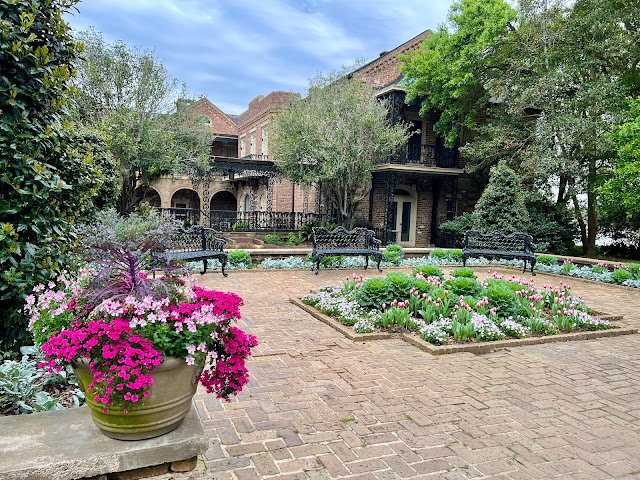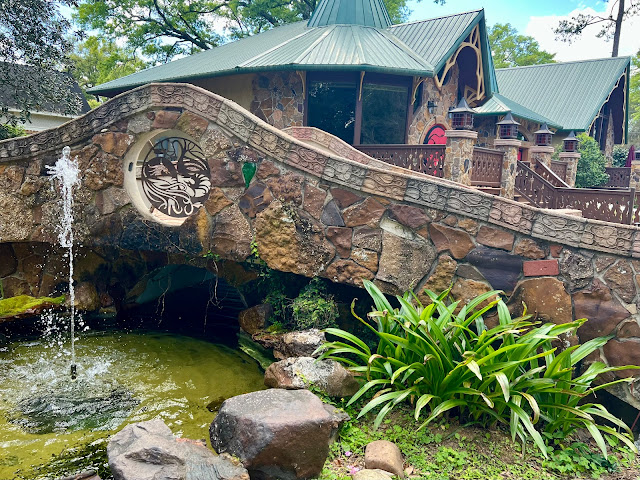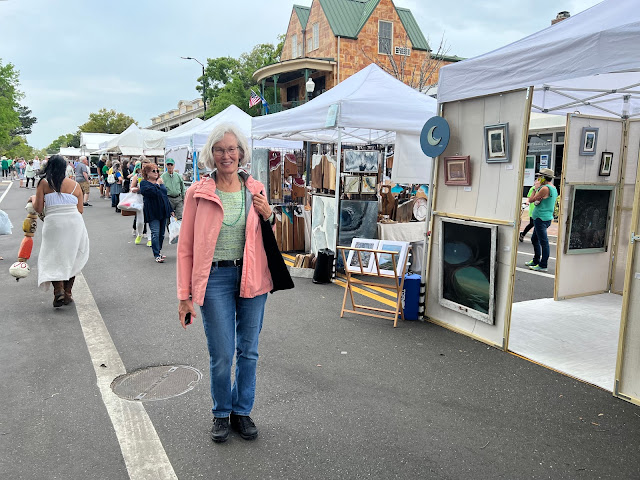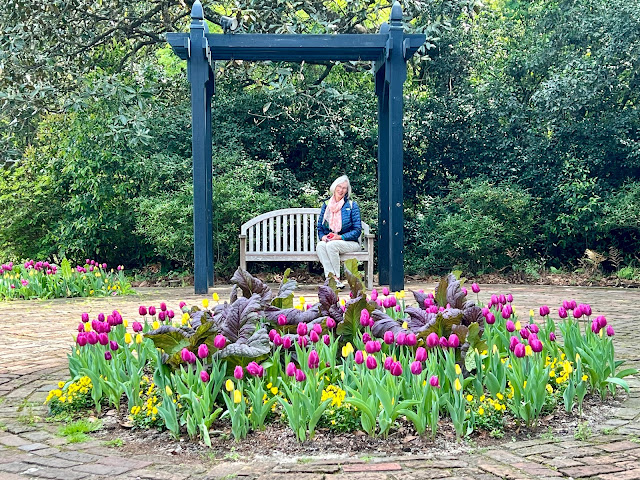Our Mobile Home!
It always amazes me how we arrive at a new spot knowing very little about the area and, during our short stay there, learn so very much!
Meaher State Park (named after John Meaher) in Spanish Fort, AL provided us a perfect location to park our mobile home during our stay in the Mobile area. Meaher S.P. is located on the causeway connecting Daphne and Mobile, giving us more than enough places to go with tons of things to see. The campground itself is quite the little treat! Campsites line Mobile Bay, treating campers to unbelievable sunsets each evening. We didn’t book our site soon enough to be directly on the bay, but that didn’t matter. There isn’t a bad campsite in the park! Besides, alligator mating season will shortly be upon us, so maybe Frankie would have proved too much temptation for those gators had we been bayside! The park has a couple of boardwalks. One is a popular fishing dock, giving us a spot to not only view the sunset, but also take in the Mobile skyline and do a little alligator watching. Mobile’s skyline may be small, but it does have the tallest building in the state of Alabama (Retirement Systems of Alabama Battle House Tower). The other boardwalk is currently under some repair, but it looks amazing! It extends way out into the bay and I can only imagine the number of alligators you can see, let alone the sunset views as you stroll safely along it!
The park has a few short trails to hike on as well as a wonderful naturalist, Chloe, who offers a wide variety of programs. Unfortunately, the only program we were around for was her “Alligator Adventures” where we learned so much and also got all of our questions answered! Thanks Chloe!
Across the highway from the campground is Five Rivers Delta Center. This is a wonderful resource center that includes a nature center, a hall for celebrations (a wedding was going on while we were there), a large park with trails, and an unbelievable number of programs and demonstrations (including fly-fishing, crabbing, coastal fishing, birding, canoeing, cast-net-throwing, waterfowl hunting, photography, alligator hunting and even wild hog hunting)! We did manage to catch a ride on their Delta Explorer, where we learned all about the Mobile-Tensaw Delta, formed from the five rivers that come together here. It makes sense that when the Mobile, Spanish, Tensaw, Apalachee, and Blakeley Rivers all meet up, you would have one heck of a waterway! In fact, this 250,000-acre area is the second largest river delta in America and is nick-named “America’s Amazon”!
We heard a really interesting side story while on the ride. Anyone familiar with Jimmy Buffet’s song, “Son of a Son of a Sailor”? Apparently, Jimmy’s grandfather really was a sailor! The Chiquimula was a schooner built in 1917 in Seattle. For a number of years, Jimmy’s grandfather was the skipper of this vessel! Eventually, the Chiquimula fell into disrepair and sat unused for years until Watt Key discovered it and brought it to Spanish Fort with high hopes of turning it into a restaurant! Before he had time to get it renovated, vandals started a fire on it and it burned to the waterline. The remains of this ship are still barely visible from the shore of the causeway. A developer had plans to build a big condo unit there, but the historical significance of this vessel got in his way and the project was scrapped.
On a more serious note, during our tour of the delta, we learned of another ship in the area that was burned to the water line and sunk, the Clotilda. The Clotilda is the last known slave ship to arrive in the US. Oral tradition has it, in 1859, Timothy Meaher (a wealthy shipyard owner in Mobile) bet $1,000 he could import slaves to the US under the federal government’s nose. He hired Captain Foster and, sadly, won the bet. Although the importation of slaves was outlawed in 1808, an African prince sold 110 men, women and children to Captain Foster who loaded them into the Clotilda and illegally snuck them into Mobile. After transferring the captives to a steamboat, he burned the Clotilda to the waterline and sank it in the Mobile River. In 1861, the federal government prosecuted Meaher and Foster for illegal slave importation, but lack of evidence resulted in the case being dismissed. Following the end of the Civil War, 32 of Meaher’s formerly enslaved people established a community now called “Africatown” smack dab in the center of the industrial area of Mobile. Under threats of violence, they were forbidden to talk of their voyage from Africa, so only oral tradition tells their horrific stories today. Netflix has an interesting documentary on the story called "Descendant". It’s worth a watch.
It was an amazing coincidence that allowed us to get together with some of our good friends from Hastings, MN! Dick and I joined the bell choir at St. Elizabeth Anne Seaton (SEAS) when we lived in Hastings and it was Marge that took me under her wing and taught me the art of ringing bells. I remembered that she and her husband (Jack) annually escape a couple of the Minnesota winters in the Gulf Shores area, so I contacted Marge to see if they happened to still be in snowbird mode. It turned out they were just going to be heading home. It was my lucky day, as they were willing to take a break from their drive and meet us for lunch at O’Charley’s in Daphne! It was great to catch up with them!
Another dear friend and her husband also happened to be visiting their daughter and family near here! Maggie and I met each other at a book study, also through SEAS, and the group has continued to include me virtually in book studies during our travels. It was delightful to finally meet her husband (Dave) over breakfast at Another Broken Egg in Fairhope! How good God is to bring such nice people back into my life – even if for such a brief visit!
A trip to Mobile requires going through a tunnel under the Mobile River! You are no sooner through the tunnel before you find yourself in historic Mobile! A quick stop at the Visit Mobile Welcome Center loaded us up with brochures and suggestions for things to see before heading out to explore. There is a driving tour of all of the historic districts filled with beautiful homes that would be wonderful to do. We turned a small portion of it into a walking tour and enjoyed strolling around the Church Street East district and reading about those historic homes and buildings. We learned that Mobile was once the capital of Louisiana as well as THE origin of America’s Mardi Gras in 1703! Once Dick realized the Mardi Gras jesters are known for conjuring up merry misrule, he couldn’t help dreaming of stirring up his own bit of misrule! Everyone knows what a trouble maker this guy is!
We all think of New Orleans as the center of Mardi Gras; however, the 18 days prior to and including Fat Tuesday brought 63 parades to the historic streets of this area! We found beads strewn in trees, over lamp posts, and generally anywhere strings of beads might get stuck! It’s not only beads that are thrown, but all types of toys and goodies. Some years back, people were getting injured from hard objects being thrown, so the tradition of throwing Moon Pies began in addition to soft toys. Word has it that Moon Pies are especially good after being warmed in the microwave for eight seconds. A huge Moon Pie sits at the top of one of the downtown buildings and is dropped at midnight on New Year’s Eve! The city takes it down each spring to protect it during hurricane season, so we felt lucky to be able to see it while we were there.
We didn’t spend a lot of time in Daphne, but we did check out their Village Point Park Preserve. I would include this boardwalk as a “not to miss” when in the area! You can find river otters along with alligators in the backwaters before reaching the bay. Once you reach the bay, you again have a sandy beach to enjoy walking along with a great view of Mobile.
Fairhope is another gem of a city! The docent at the Visit Mobile Welcome Center pointed out a small neighborhood located off of Oak Street that has the most amazing castle-like homes you can imagine! The original castle was built in 1946 by Craig Sheldon and expanded from there. In construction, Craig recycled, repurposed and reused many materials. His biggest gift to the construction is his incredible imagination! There are a couple of studios on AirBnB you can rent if you want to stay overnight in a storybook castle!
The historic area of Fairhope includes a French Quarter that has several restaurants and cute shops. Although we didn’t have the chance to try them out ourselves, we heard Panini Pete’s has the best beignets around.
Fairhope happened to be hosting their annual Arts and Crafts Festival while we were in town. Going to that was a no brainer! It was quite the coincidence that the artist I purchased a pair of earrings from was staying at Meaher S.P. also. I don’t think I have ever experienced such a large arts and crafts festival in my life! It stretched out for blocks in every direction and had such amazing art of all material!
 |
| Winston Groom, author of Forrest Gump, called Fairhope his home! |
Fairhope also has a great beach and pier within easy walking distance from downtown. It’s a delightful spot to pack a sack lunch and spend a little time at!
Bellingrath Gardens was a bit of a drive, but definitely worth it! The property was originally purchased by Walter and Bessie Bellingrath in 1917. Walter was a wealthy Coca-Cola bottler and it was his doctor who encouraged the purchase of this fishing camp, telling Walter it was time he learned to play. Bessie wasn’t so interested in the fishing portion of their 65-acre, riverfront property, but rather wanted to create beautiful gardens there.
 |
| Camellias, their Bessie's flower! |
 |
| Lilies with Fowl River in background |
As the gardens were being created, Walter and Bessie found themselves spending so much time there and enjoying it so very much that they decided to build their home there as well. Not wanting their home to look new, they were able to use reclaimed handmade brick and ironwork from a landmark 19th century hotel in Mobile that was being demolished.
 |
| All of the gardens are replanted four times a year! |
The property includes trails that wind you through such a variety of gardens. As we were walking on a trail past Mirror Lake (really more of a pond), we came across the most romantic scene I have ever witnessed! A young man was on a small peninsula of the lake next to a garden of red tulips in full bloom with a bouquet of flowers. Next to him was an easel with a sign on it that read “Will you marry me?” By the time we were on the other side of the lake, we looked back at the scene just in time to see the woman he loves coming down the trail. We couldn’t help catching a photo of him getting on his knee and proposing to her!
The Asian Garden was another treat! This garden was created after the park was established, but has a huge nod to Walter! The Coca-Cola sign reads “Drink Coke” in Japanese!
For our final night in the area, we treated ourselves to dinner at The Original Oyster House, located a mile down Hwy. 98 from our campground. It was delicious and offered an equally spectacular sunset view! I got a kick out of a sign in their bar – "Redneck Riviera"! Maybe Alabama has a reputation of being a little “redneck”, but we found it absolutely wonderful!
Next up: Livingston, Louisiana!






































Comments
Post a Comment